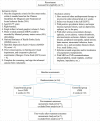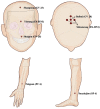Effects and central mechanism of electroacupuncture and MRI-navigated rTMS for PSD: study protocol for an fMRI-based single-center, randomized, controlled, open-label trial
- PMID: 38250275
- PMCID: PMC10799680
- DOI: 10.3389/fpsyt.2023.1226777
Effects and central mechanism of electroacupuncture and MRI-navigated rTMS for PSD: study protocol for an fMRI-based single-center, randomized, controlled, open-label trial
Abstract
Background: Post-stroke depression (PSD) is the most common mental complication after stroke and has a serious impact on functional outcomes and quality of life for stroke patients. Antidepressants are the first-line treatment for PSD; however, many reported side effects remain. Clinical research and practice guidelines have shown that electro-acupuncture (EA) or rTMS have a positive effect on PSD. However, there are few clinical studies on EA and MRI-navigated rTMS for PSD that explore the fMRI-based central mechanism in depression.
Methods: In this randomized, controlled, open-label trial, 64 patients with PSD will be randomly allocated into the experiment group (n = 32) or control group (n = 32). The experiment group will receive EA and MRI-navigated rTMS and the control group will receive MRI-navigated rTMS treatment, in 12-20 sessions over 4 weeks. In addition, 10 healthy people for fMRI scanning will be recruited as a healthy control group without any intervention. The primary outcome will be the change from baseline in the Hamilton Depression Scale-24 item (HAMD-24) scores at week 4. The primary analysis of the central mechanism will mainly involve cortical morphology, local spontaneous brain activity, and the default mode network (DMN) functional connectivity based on fMRI at 0 and 4 weeks. Secondary outcomes will include the neuro-patho-physiological and quality of life changes in cortical excitability, determined using the motor evoked potential test (MEP), National Institutes of Health Stroke Scale (NIHSS), EuroQol Five Dimensions Questionnaire (EQ-5D) Scale, Modified Barthel Index (MBI) Scale, and Health Scale of Traditional Chinese Medicine (HSTCM). Additional indicators will include the Acceptability Questionnaire and Health Economics Evaluation (cost-effectiveness analysis) to assess the acceptability and economic practicality of the treatment under study. Outcomes will be assessed at baseline and post intervention.
Discussion: EA and MRI-navigated rTMS therapy could become an alternative treatment for PSD, and it is expected that this trial will provide reliable clinical evidence and a potential central mechanism for the future use of EA and MRI-navigated rTMS for PSD.
Clinical trial registration: NCT05516680, ClinicalTrials.gov (registered in August 2022).
Keywords: MRI-navigated rTMS; activity of daily living; electro-acupuncture; functional magnetic resonance imaging; post-stroke depression; randomized controlled trial; study ADL.
Copyright © 2024 Lu, Wang, Shen, Ruan, Lu, Wang, Song, Fan, Li, Shi, Xia and Xu.
Conflict of interest statement
The authors declare that the research was conducted in the absence of any commercial or financial relationships that could be construed as a potential conflict of interest.
Figures
Similar articles
-
Efficacy and safety of electroacupuncture for post stroke depression: study protocol for a randomized controlled trial.Trials. 2018 Mar 2;19(1):152. doi: 10.1186/s13063-018-2548-0. Trials. 2018. PMID: 29499745 Free PMC article.
-
Efficacy of acupuncture on cognitive function in poststroke depression: study protocol for a randomized, placebo-controlled trial.Trials. 2022 Jan 28;23(1):85. doi: 10.1186/s13063-022-06011-7. Trials. 2022. PMID: 35090538 Free PMC article.
-
Integrative medicine in treating post-stroke depression: Study protocol for a multicenter, prospective, randomized, controlled trial.Front Psychol. 2022 Aug 29;13:923506. doi: 10.3389/fpsyg.2022.923506. eCollection 2022. Front Psychol. 2022. PMID: 36110277 Free PMC article.
-
Effects of low-frequency rTMS combined with antidepressants on depression in patients with post-stroke depression: a systematic review and meta-analysis.Front Neurol. 2023 May 19;14:1168333. doi: 10.3389/fneur.2023.1168333. eCollection 2023. Front Neurol. 2023. PMID: 37273720 Free PMC article.
-
Acupuncture combined with repetitive transcranial magnetic stimulation for the treatment of post-stroke depression: a systematic evaluation and meta-analysis based on a randomised controlled trial.Front Neurol. 2024 May 16;15:1360437. doi: 10.3389/fneur.2024.1360437. eCollection 2024. Front Neurol. 2024. PMID: 38817548 Free PMC article.
Cited by
-
Research hotspots and trends of post-stroke depression rehabilitation: a bibliometric analysis from 2003 to 2024.Front Neurol. 2025 Apr 4;16:1526506. doi: 10.3389/fneur.2025.1526506. eCollection 2025. Front Neurol. 2025. PMID: 40255888 Free PMC article.
References
Associated data
LinkOut - more resources
Full Text Sources
Medical



